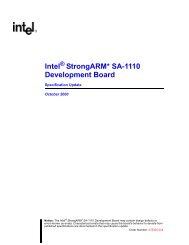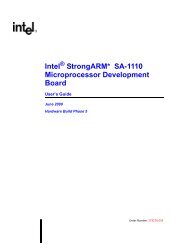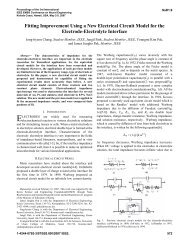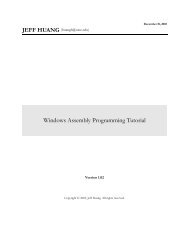Beej's Guide to Network Programming Using Internet Sockets
Beej's Guide to Network Programming Using Internet Sockets
Beej's Guide to Network Programming Using Internet Sockets
- No tags were found...
You also want an ePaper? Increase the reach of your titles
YUMPU automatically turns print PDFs into web optimized ePapers that Google loves.
Beej’s <strong>Guide</strong> <strong>to</strong> <strong>Network</strong> <strong>Programming</strong> <strong>Using</strong> <strong>Internet</strong> <strong>Sockets</strong> 548.11. inet_n<strong>to</strong>a(), inet_a<strong>to</strong>n()Convert IP addresses from a dots-and-number string <strong>to</strong> a struct in_addr and backPro<strong>to</strong>types#include #include #include char *inet_n<strong>to</strong>a(struct in_addr in);int inet_a<strong>to</strong>n(const char *cp, struct in_addr *inp);in_addr_t inet_addr(const char *cp);DescriptionAll of these functions convert from a struct in_addr (part of your struct sockaddr_in,most likely) <strong>to</strong> a string in dots-and-numbers format (e.g. “192.168.5.10”) and vice-versa. If youhave an IP address passed on the command line or something, this is the easiest way <strong>to</strong> get a structin_addr <strong>to</strong> connect() <strong>to</strong>, or whatever. If you need more power, try some of the DNS functionslike gethostbyname() or attempt a coup-de-tat in your local country.The function inet_n<strong>to</strong>a() converts a network address in a struct in_addr <strong>to</strong> a dots-andnumbersformat string. The “n” in “n<strong>to</strong>a” stands for network, and the “a” stands for ASCII forhis<strong>to</strong>rical reasons (so it’s “<strong>Network</strong> To ASCII”–the “<strong>to</strong>a” suffix has an analogous friend in the Clibrary called a<strong>to</strong>i() which converts an ASCII string <strong>to</strong> an integer.)The function inet_a<strong>to</strong>n() is the opposite, converting from a dots-and-numbers string in<strong>to</strong> ain_addr_t (which is the type of the field s_addr in your struct in_addr.)Finally, the function inet_addr() is an older function that does basically the same thing asinet_a<strong>to</strong>n(). It’s theoretically deprecated, but you’ll see it alot and the police won’t come getyou if you use it.Return Valueinet_a<strong>to</strong>n() returns non-zero if the address is a valid one, and it returns zero if the addressis invalid.inet_n<strong>to</strong>a() returns the dots-and-numbers string in a static buffer that is overwritten witheach call <strong>to</strong> the function.inet_addr() returns the address as an in_addr_t, or -1 if there’s an error. (That is the sameresult as if you tried <strong>to</strong> convert the string “255.255.255.255”, which is a valid IP address. This iswhy inet_a<strong>to</strong>n() is better.)Examplestruct sockaddr_in antelope;char *some_addr;inet_a<strong>to</strong>n("10.0.0.1", &antelope.sin_addr); // s<strong>to</strong>re IP in antelopesome_addr = inet_n<strong>to</strong>a(antelope.sin_addr); // return the IPprintf("%s\n", some_addr); // prints "10.0.0.1"












